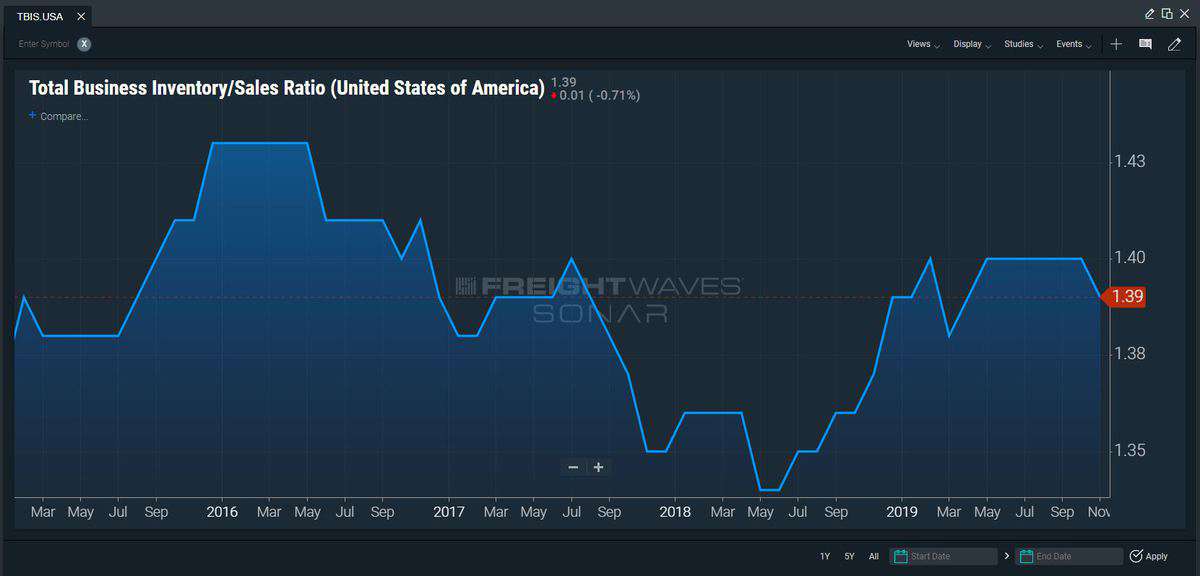Year-over-year comps are improving, but the impact from the coronavirus and continued production halts on Boeing’s 737 provide challenges for the freight environment in 2020, said Jack Atkins, managing director of Stephens Inc.
Atkins, speaking at the Katz, Sapper & Miller 2020 Trucking Owners and Leaders Roundtable on Feb. 4 in Indianapolis, said 2019 was a “return to normal” for carriers but felt like “death valley” because of the strength of 2018.
“We saw a very robust 2018 that benefited from the tax cuts and pull forward [of freight due to tariffs],” he said. “It’s going to feel more normal this year and you have [more favorable] comps.”
Atkins said Stephens is “more optimistic on how freight will feel” in 2020.
On the demand side, Atkins sees GDP, housing starts (SONAR: SFAM.USA), continued retail sales strength and the inventory-to-sales relationship pushing freight demand. Housing starts “could be the surprise of 2020,” he said. “It’s been stable over the last couple of years, but there is some hope [that they will rise]. There is a lot of freight that moves with housing starts,” Atkins said.

Challenges remain on the supply side though. The industrial economy has been in a recession, Atkins said, but January’s Purchasing Managers’ Index rose for the second straight month to 52.1, giving hope that an industrial turnaround is happening.
The inventory-to-sales ratio stabilized at 1.40x in January (SONAR: TBIS.USA), showing that excess inventories are “burning off” and “should help freight flows,” Atkins said. The burnoff started to occur once “tariff policy began to stabilize.”

The strong freight flows in 2018 led to the excess capacity situation that exists today, Atkins said. U.S. total sales rose 1.8% through November 2019 and inventories were up 1.3% in the same time frame. While sales have continued to rise, inventories have leveled off.
“Folks in this room can’t control themselves in a good market,” he said. “They add a truck, add a truck, and boom, we’ve added 5% capacity.”
Recent Class 8 orders, though, suggest some attrition taking place, and truck employment has dropped 75 basis points since July, when it peaked at 1,520,000, Atkins said.
Freight flows are facing concerns over the coronavirus, Atkins said. “It is certainly stopping and slowing production in China, which is having the same effect as the inventory glut in 2019,” he said.
In terms of rates, Atkins said truckload contract rates have firmed up and “we are in a more balanced market than we were 90 days ago.” Bid season may see rates down just 1% — not the 3% or 4% many expected — and shippers are expecting rate increases in the second half of the year.
“We believe shippers are using the soft market to pull forward bids in an effort to get better rates,” Atkins said.
Spot rate increases are likely coming as well, with mid- to high-single-digit increases by May.
The banking perspective
As the economics of the industry change because of the freight environment, so too is the availability of credit. In a separate panel, top bankers talked about how there is some improvement in the lending environment but that carriers can expect banks to remain focused on ensuring they are making good loans.
Michael Letsch, senior vice president of transportation and logistics for Bank of America (BoA), noted the bank “lost several million dollars” on the Celadon bankruptcy late last year, so BoA will look for strong balance sheets. With that said, Letsch said carriers should ensure they have varied sources of cash.
“The [more] triggers you can pull, the flexibility is huge,” he said. “If you are negotiating your equipment leases … make sure you have sources from different buckets.”
Also, many carriers may be facing strong headwinds that may make meeting covenants difficult. Letsch said communication is key.
“If you are having a challenging year, talk to your bank early, don’t wait until you turn in your financials because that will make things worse,” he said.
Letsch said with the Federal Reserve suggesting rates will remain flat this year, carriers can expect rates to remain flat or perhaps even decline slightly. Pressure on banks to improve margin, though, is increasing.
Bank competition from nontraditional lenders is increasing and many are offering more flexible covenants, Letsch said.
Both Filip Gagovic, senior vice president of Huntington Bank, and Michael Sabbath, senior vice president of business development for UMB Bank, echoed some of Letsch’s thoughts. When it comes to covenants, Sabbath advised looking at the balance sheet.
“Covenants are predicated on how your balance sheets look,” he said. “Some products have no covenants whatsoever and give you more flexibility.”
Communicating about both your business and your customers’ businesses to your banker and remaining proactive regarding management of financials are keys that Sabbath looks for in a client.
“If we understand your business and the shipper’s, we’ll find a way to get [financing] done,” Sabbath said.
Gagovic noted that if you view something as a risk, the lender will as well.
“If you have something that is perceived as a risk, find ways to mitigate it,” he said. “If you are 100% owner-operators, [that may be fine] but explain why you like that model.”
He said to focus on lane density and revenue per mile as key metrics that can improve the lendability of any carrier.










